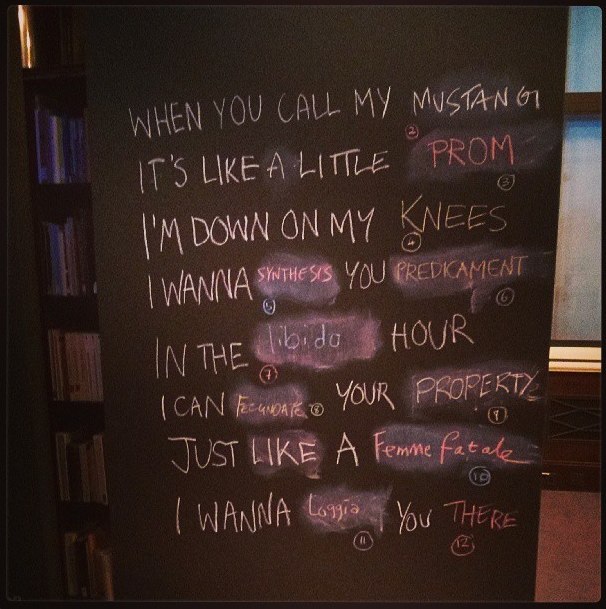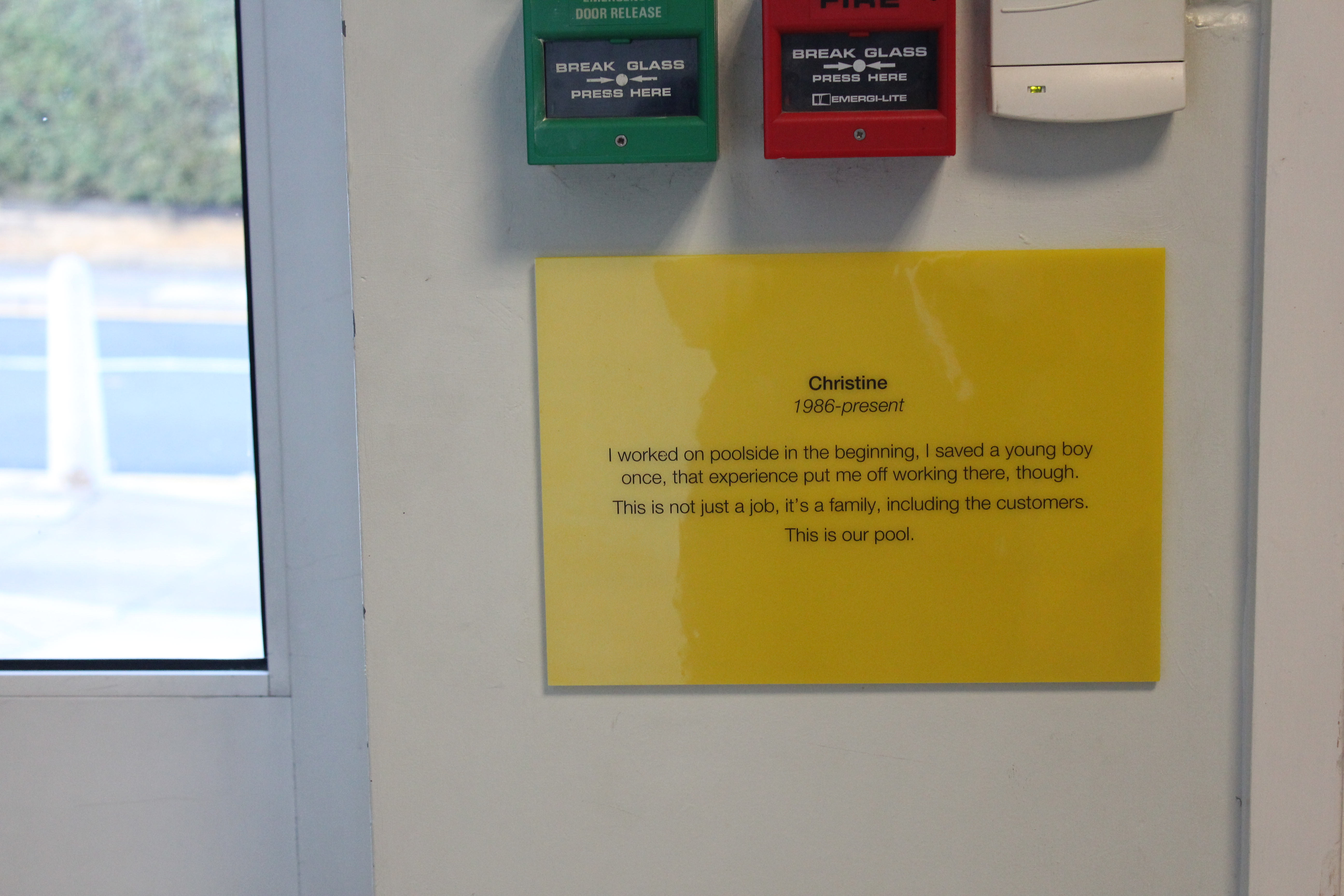
Games! I’ve been all ‘theatre theatre theatre’ for a bit, so you’ll all be glad, I’m sure, to receive this update on a bit of game design for the failure-themed WRONG! event at the Wellcome Collection curated by the brill-o Sarah Punshon. The theme was wrongness, mutation, and failure in science, art and society. Brill stuff. So many other brill designs and contributions, performances and lectures. My contributions included one very gamey game, and one probably-art-game. The first was very simple but a pleasure to see people play. I’ve rephrased the instructions AGAIN. (Playtesting with 5-10 people at work does not prepare you for how a 1000 slightly drunk people will play.) And they are as thus:
Dictionary Jam!
A game of mutation through the night…Items: a large blackboard, chalk, erasers, large dictionaries, plenty of d6 dice, and dice that read 1, 2, and 3 pages fwd/back. The blackboard shows a very very well known song lyric (one everyone can hear the tune to – it’s funnier that way) with 11 of the words (key verbs and nouns usually) numbered 2-12
Rules:
1) roll two of the normal ‘number’ dice to find out which word you get to change!
2) pick up a dictionary, and find that word!
3) roll the ‘page number’ die, to find out how many pages forward or back to turn
4) pick a new word from that page, erase the old one and replace it with your chosen word!
5) take a lollipop! (if you want)
Here’s a picture of it about half way through the night. People enjoyed. The later it got the more people wanted it explaining in person. I was happy to do that. People loved coming up with funny/rude words, a lot of people sang out loud and laughed. It was satisfying to see someone ‘win’ a word number 2 or 12 (double 1 or double 6) which were rarer and would stay longer. As people got drunker and charged in without seeing the big dedicated ‘how to play’ blackboard and changed things just to words they liked I quietly re-set them, as having the close-letter variants up helped explain the rules visually.
So, simple, but fun. Amazing to see all the people staring and laughing and enjoying! In case you’re wondering the loose science/wrong link is in the combination of by-chance and choice-driven mutating lyrics. REPRODUCTION.
And then the other game I made was way more art-y. And along the same line of ‘passing things along, slightly ‘wrong”. The art-game was simple to explain, a bloody nightmare, it turned out, to write. Sarah was really helpful on this. Playtested it on friends and relatives in the final hours for me. So, here’s what it was:
Once Upon a Tape Recorder
Items: 3 x tape recorder, headphones, instructions, pencil, notepaper
Rules: Player one sits down and presses ‘play’ – they hear a story and some instructions, the instructions explain that their job is to listen, and then re-tell the short (2 minute) story, along with the instruction to pass it on. Chinese whispers that erase the previous telling. They are allowed to make notes before telling if they like.
Below are the three versions that the tape recorders were left with at the end of the night, followed by the original text.
The third one, actually, gives you a taste of me telling that orignal story – as it was ‘broken’ a bit by some quite young kids towards the end of the night (they were understandably excited by the technology, and left a mostly blank message) so I put it back on track by retelling my own story version. It was quite late on, and no one seems to have wanted to record over it again. On that point a lot of people spoke about not wanting to ‘ruin’ others’ stories. And so too the first one I had written. I’ve thought about this – I could have made the telling less mundane, but then it would be less memorable, and I think would have made people more factual and less beautiful when they did choose to erase. I think I’m reconciled to that. Though ‘running it’ I discovered that it was pretty easy to see if one wasn’t getting the instructions across anymore – and jumped in just for 1 of the 3 as above. Before I worked out what a ‘this is broken’ reaction looked like, though, it was nerve-wracking to watch people talking into the recorders and not knowing if they were getting the instructions etc. But 2/3 of them worked throughout the whole 4 hours. There were always people in the booths throughout the night (which would be 16 max mutations). And I should say not re-recording is a valid reaction. Totally. So here’s the three versions. Check out number 1 for my favourite, which has a series of snippets of different endings from people who spoke longer than others. That’s possibly my most favourite thing.
(THIS ONE GOT WELL SEXED UP ^)
And finally, here’s a lovely drawing someone left on their notepaper, and the original text
Once Upon a Tape Recorder:
You are going to hear a story. I am going to tell you a story. A story that is different every time, that will change with each telling. Chinese whispers from ear to ear. Never ending, always changing. It won’t take long, a couple of minutes, your job is to listen, just listen, and then pass it on. All you need to remember is the story, and to pass on these instructions. If you like, you can read out the ones written next to the recorder. Are you ready? Sitting comfortably? Volume as loud as you want it to be? (the control is on the right side of the machine)…
This is a story. And like all good stories it begins:
Once upon a time, there was a girl. There was also a boy. Because this is the way of these things. Except when there’s two boys. Or two girls. There are versions of the story where that is true. But In this version of the story, it’s a girl and a boy.
So,
There are a girl and a boy. And a room. But the boy isn’t in the room yet. Just the girl. She is sitting next to an open fire that she can ill-afford the gas for, and leaning across to knock up the needle and put a new record on, one she quietly hopes will impress the boy when he walks back in. One she likes, but also one she thinks will make her seem impressive. She carefully holds the disc by its edges and lowers it onto the turntable. That satisfying ‘whumph’. And a tiny shiver. Outside it is that time of year when the days are short and outdoors is a battle against the cold.
And then the boy enters, he hands her a glass of ruby red wine and he crouches and puts his head on her shoulder as they sits on the rug in front of the fire.
There is a moment. She breathes in. He kisses the gold of her hair. And then he moves forward.
This mistake, dear listener, is small. Simple too. Maybe it is the movement. Or the few simple silly words that follow. Like the first pebble that goes flying down the edge of a mountain before the rocks ensue.
The words tumble out of her mouth ‘One day I’ll put on an album you’ll like’ as he moves forward to change the music. He pauses. Like a glitch. And from that small, offhand sentence blossoms a whole silence filled with her never feeling good enough. Because she wasn’t. For him. Which he sees, then. And one of those conversations follows. With “you’re wonderful but”, and tears. And break up sex. And a billion carefully held futures snuffed out in a moment.
And it’s not a mistake because she misses him. (She does). And it’s not a mistake because she shouldn’t have felt it (She did). And it’s not a mistake because they should still be together (they shouldn’t). It’s a mistake because it’s un-doable. It’s a mistake because she feels – somewhere she can’t rationalise away- that if she hadn’t said that, it would all still be ok.
That’s the story I want to offer you. A story about a small, sad, mundane mistake. Like most of the ones we make. Only you will hear it told that way. Your job is now to retell it. You can write notes if you want, to help you. And you can use the instructions on the note page to help you pass on what they need to do. But mostly, find your own way of retelling it. Remember to help make the next person feel ok. Be Kind, and remember to Rewind after recording. Thank you.


